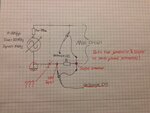David_
Advanced Member level 2
I have a digital two channel oscilloscope and a digital function generator both referenced to earth ground.
But my generator does not provide the output current i need for a couple experiments and I've built a weak ass power amplifier, not really its just a buffer BUF634 but i'm going to try out different current-boost solutions.
However i would like to do some measurements where the scope ground is not at the voltage source negative and the obvious solution would be to disconnect the generator earth reference but for one i don't see it as a viable and safe idea but as a second reason i find it really pleasing to try to solve it another way.
The output buffer can be powered from a floating source but if i don't connect the grounds i get some strange distortion on the output signal, i have seen some IC solutions but the are to expensive to buy. but there are a lot of isolators available.
Is it possible to buffer a signal that is earth ground referenced and get a floating output without one of these isolators?
I hope i can find some solution that does not require me to buy any expensive special IC, rather build my own solution with cheaper parts if possible.
Output current is a concern but i cant find a viable option to start with, can instrument amplifiers or differential amplifiers help me in some way?
Or should i aim for a homebrew differential oscilloscope probe?
The aim is to be able to treat the generator output as a floating source to take measurements from with the scope while both the scope and generator is still earth referenced.
But my generator does not provide the output current i need for a couple experiments and I've built a weak ass power amplifier, not really its just a buffer BUF634 but i'm going to try out different current-boost solutions.
However i would like to do some measurements where the scope ground is not at the voltage source negative and the obvious solution would be to disconnect the generator earth reference but for one i don't see it as a viable and safe idea but as a second reason i find it really pleasing to try to solve it another way.
The output buffer can be powered from a floating source but if i don't connect the grounds i get some strange distortion on the output signal, i have seen some IC solutions but the are to expensive to buy. but there are a lot of isolators available.
Is it possible to buffer a signal that is earth ground referenced and get a floating output without one of these isolators?
I hope i can find some solution that does not require me to buy any expensive special IC, rather build my own solution with cheaper parts if possible.
Output current is a concern but i cant find a viable option to start with, can instrument amplifiers or differential amplifiers help me in some way?
Or should i aim for a homebrew differential oscilloscope probe?
The aim is to be able to treat the generator output as a floating source to take measurements from with the scope while both the scope and generator is still earth referenced.
